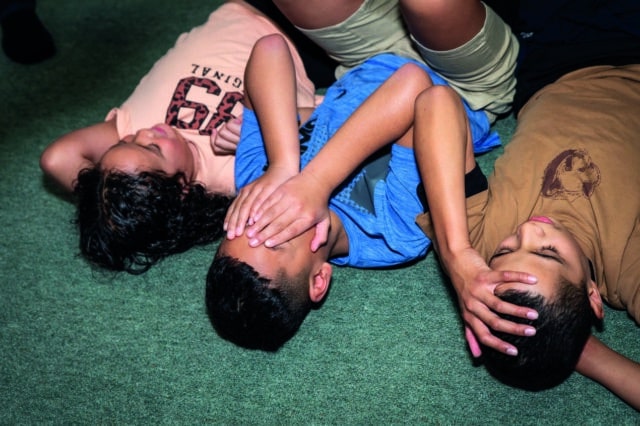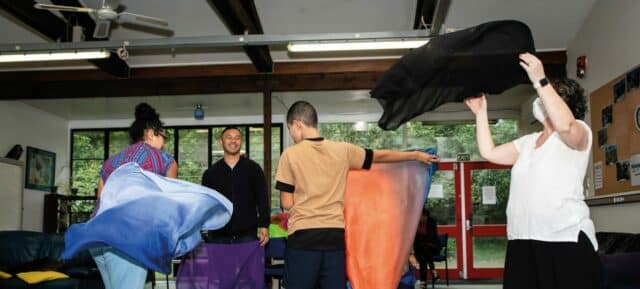
School is typically an environment of unpredictability, pressure around positive peer relationships and a range of sensory stimulation. This can be challenging for many children but is particularly difficult for Autistic children where autism and anxiety frequently go hand in hand. Just going to school can be a battle for these children and staying at school can be a living nightmare.
Autistic students often experience anxiety at times when the demands placed upon them are simply too much. Changes to the normal class routine, a relief teacher, whole school events; these ‘normal’ school elements can feel anything but normal for Autistics. An unmet need to know what is coming up, how long something will take and what it will involve puts the many Autistic learners in a position of feeling very unsafe. Sensory overload is another common reason why these students’ anxiety increases.
“My son has very much struggled to ‘fit in’ at school. He found it challenging to find his place and feel positive about how school operates and the expectations it puts on him.” [Amia, parent of Denny, aged 10]
How anxiety ‘looks’ is individual to each Autistic child but there are some commonalities: increased talking and stimming (often hand flapping), leaving their seat, negative body language, refusal to engage in a learning task, leaving the classroom. For some students a phrase such as “this is boring” can be an indicator that their anxiety is on the rise. Certain times of the day are likely to be anxiety-inducing . For Autistic students the unstructured and often unpredictable nature of interval and lunch time can be a minefield. Verbal onslaughts to and from peers and, sometimes, physical altercations can occur because these students do not have the skills or understanding to navigate the social jungle that is the playground.
“He becomes very agitated in situations where he cannot make himself understood and this makes him increasingly upset. I find it hard to connect with him and calm him at times like this.” [Sally, Year 1 teacher]
So, what works for Autistic students? How can we ensure that anxiety does not overshadow their educational journey? It is important to note from the outset is that what works for one Autistic student may not work for another. There is evidence-based research, however, around key strategies that are often effective. One that ticks all the boxes is prioritising the home / school partnership. As one parent states: “the line of communication between home and school is so, so important; it should be nurtured, not squashed”. Valuing this communication acknowledges that the parent is the ‘expert’ of their child and the strategies they use at home are likely to be effective at school as well. Regular and meaningful communication between teacher and parent can go a long way to reducing anxiety for the child as well as the parent and teacher.
Small adjustments can have a major, positive impact in the classroom. Chris, a Year 5/6 teacher in Nelson, “allows students to bring one item from home in case they become worried”. In his experience a student’s special interest focus is often the ‘one item’ which provides support. As Sally notes, her Year 1 student “definitely lights up and is much more engaged” when his learning is based on his special interests. Indeed, for Autistics a learning programme that includes an interest-based element can be successful and research supports this. A strengths-based approach is also critical: for Autistic students to reach their potential, there must be planned, collaborative, strengths-based and person-centred support and intervention (Goodall, 2014; Meer & Evans, 2021).
“My son’s RTLB has advocated for him loudly, from a place of genuine care. She has been able to pull in support to surround Denny with a village. She has educated myself, other whānau and his teachers.” [Amia, parent]
Removing barriers to learning is key if Autistic children are going to see school as a place that they enjoy and that is free from anxiety. A sticking point for many Autistics is changes to the ‘norm’ and what they usually experience.
“Definitely changes to routines can trigger my ākonga (student) to opt out of what is happening which can mean he removes himself and he goes off to do something else – usually running around outside.” [Sally, Year 1 teacher]
An unfamiliar event such as Athletics Day can become such a source of worry to the student that they think of nothing else and are unable to focus on learning. As Year 5/6 teacher Amie explains, “it is better to ditch cross-country training if it is causing so much anxiety that other learning stops”. A teacher who is willing to be flexible in their approach, therefore, is far more likely to meet an Autistic student’s needs and, in turn, reduce their anxiety.
Another barrier to learning can be the teacher themselves. Teachers need to be willing to ensure that learning goals are directly linked to the Autistic student’s need. Setting a positive tone for social relationships in the classroom is the teacher’s responsibility, as is modelling positive interactions with students. This is facilitated by those teachers who realise that change needs to happen within them as practitioners, rather than the student. It also acknowledges that specialist support, such as RTLB (Resource Teachers of Learning and Behaviour) is sometimes needed and embracing it will be hugely beneficial.
Any kind of transition can be hugely challenging for Autistic students. Home to school, teacher to Teacher Aide, classroom to playground, moving between group rotations, school to home – anxiety is often at its peak during these times. Large-scale transitions such as moving to a new class or new school can cause anxiety for weeks, possibly months. As one mum says: “my daughter has been worried about next year since the start of this year.” To forewarn the student is to, hopefully, forearm them. For example, small-scale transitions within the classroom can be managed through regular check-ins with the student prior to the transition itself.
For larger transitions, such as a change of school, a more specialist service such as RTLB can be employed. The school SENCO (Special Education Needs Coordinator) or LSC (Learning Support Coordinator) can also provide robust support. As one SENCO explains: “we transition Autistic students to their new class and arrange early meetings with their parents. We also help with IEPs (Individual Education Plans) where needed.” This team approach is vital and it should have the student as part of this team. One Nelson RTLB emphasises that gathering a student’s voice around what can help them “can support the student to focus on things that they can control, rather than things they can’t.”
“My daughter appears to be having a good time and coping at school. Across all of her primary school years we were not believed by her teachers. I feel it is an ongoing battle to help others to understand the specifics of autism.” [parent of a Year 6 student]
Where educators can become misguided is expecting all Autistic students to be the same in terms of their presenting challenges and manifestations of anxiety. Masking for girls, for example, is common, to the extent that there are almost two different students: the ‘school’ student and the ‘home’ one. The school day can seem to be manageable for some girls whereas, in reality, the anxiety builds as the day progresses. One mum shares that her daughter “comes home from school most days in a big wound-up mess and has many meltdowns and shutdowns due to the anxiety and stress that she has held in at school.” Researchers, RTLB, SENCO / LSCs and parents concur: an increase in teachers’ and school leaders’ understanding of, and response to, autism is key. If a teacher truly understands autism and the individual Autistic student a key shift, or “paradigm shift” as Autistic educator Dr Emma Goodall puts it, occurs. The approach then becomes solutions-focussed, based on the teacher’s belief that the student is capable and has potential (Goodall, 2014).
There is a consensus amongst education and health professionals that there is growing understanding of autism and how it presents differently at different ages and that autism in girls may present differently to boys. Educators, in particular, are realising that neurodiversity is actually very common and they have the responsibility to support the learning needs of these children whether they have a diagnosis or not. This can have a positive impact on parents. Amie, a teacher of twenty years, believes that this increased awareness has “empowered parents to pose inquiries and nurture a sense of curiosity about their child’s development”. Frustratingly, though, increased awareness and empowerment does not equal increased resourcing for teachers. Perhaps, as one parent points out, the future focus should be ongoing professional development: “to have compulsory training in neurodiversity with regular refresher courses would make a huge difference in knowledge, empathy and understanding”.
So, what of the future for our Autistic students in Aotearoa who experience anxiety? It certainly looks brighter. Professionals are more adept at identifying autism and many now acknowledge that autism in girls can look quite different. Schools are more open to making often small adjustments to a student’s day in order to minimise their potential anxiety. Specialist support is often called upon to support teachers in meeting Autistic students’ needs. A child’s sensory needs are increasingly considered to ensure that their learning environment is conducive to learning. Do we have the perfect system? Absolutely not. Can school still feel like a battle? Sometimes. Are we on the right pathway to seeing improved outcomes for our Autistic students? Quite possibly.
Cath Dyson is a newly appointed Altogether Autism Autistic Advisor and RTLB in Nelson. She received her autism diagnosis at 47 and ADHD diagnosis at 48.
This article first appeared in the Altogether Autism Journal, 2023.
References
Goodall, E. (2014). Supporting teachers’ journeys towards full inclusion of students on the Autism Spectrum in New Zealand. The Journal of the International Association of Special Education (15)2, 133-141.
van der Meer, L. & Evans, K. (2021). The autism diagnostic process in New Zealand:
Final report. Autism CRC. Retrieved from https://www.autismcrc.com.au/sites/default/files/reports/1-058_NZ-Diagnostic-Practices_Final-Report_2021.pdf




